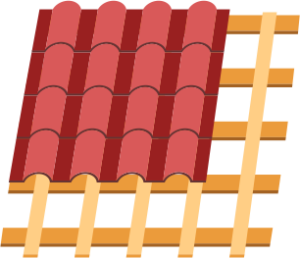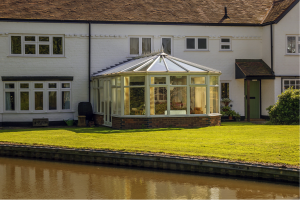Roof Care Guide
How to take great care of your roof whether it’s standard maintenance or a post storm check up.
Written on December 16, 2016
It doesn’t matter whether your roof is brand new or decades old; it still needs the occasional  maintenance to ensure that your home is adequately protected from the elements.
maintenance to ensure that your home is adequately protected from the elements.
If you feel confident enough to get up on a ladder, you can and should inspect your roof at least once per year, particularly before winter and after any severe weather.
If, for example, any roof tiles get dislodged during a storm, the resulting damage can quickly spiral out of control if you don’t deal with the problem quickly.
In this guide, we’ll be looking at the various roof care and maintenance routines that homeowners should adhere to.
Key Points
You should carry out an annual roof inspection to identify any problems.
When inspecting your loft, be sure to look out for any mould or mildew, since this indicates a damp problem, either due to a leaking roof or poor ventilation.
Cleaning clay or brick tiles is typically best done with a pressure washer at no more than 1,200 PSI, with the nozzle no closer than a foot away from the surface.
You should inspect your gutters several times per year, especially after storms and throughout the autumn.
You can install gutter guards to prevent the build-up of leaves and other debris.
Call a professional roofing contractor if you suspect there might be any serious damage.
Carrying Out A Roof Inspection
Carrying out an annual roof inspection both externally and internally will help you identify most problems before they become complicated and expensive to fix.
If you already suspect that the roof might have problems, you should also consider hiring a professional roofing contractor to carry out an inspection and provide you with a detailed report.However, in most cases, it’s easy enough to inspect the roof yourself, even by just using a pair of binoculars from the ground and examining the loft space.
It is important, nonetheless, to get a view from as many angles as possible so you don’t miss anything.
When examining the surface of your roof, be sure to look out for the following:
- Cracked, dislodged or missing roof tiles
- Rusty spots on flashing and cracked caulk
- Blocked gutters or downspouts
- Substantial amounts of moss or algae
- Damaged mortar around the chimney
By far the most serious problem, at least if it’s left unattended, is missing or damaged roof tiles.
Other factors are usually easy to deal with and do not present a major problem.
A build-up of moss or algae rarely indicates any problem with the roof, but it may present a cosmetic concern.
Finally, if your roof has a covering of felt tiles, be sure to look out for an excessive build-up of granules in the gutter systems, since these could indicate that the protective covering on the tiles is starting to fail.
Roof And Loft Space Ventilation
Lofts often get forgotten about, but it’s just as important to inspect these areas of the home on a regular basis as it is the surface of the roof itself.
Many homes do not have enough roof ventilation, which can lead to damp and mould, thus hindering the overall performance of the structure.
Proper ventilation is essential to help regulate the temperature difference between the interior and exterior regions of the roof as such that it helps prevent the build-up of moisture and keeps humidity to a minimum.
If there’s a lack of ventilation, the structure of your roof will deteriorate at a much faster rate while also having a significant impact on your energy bills as well as the comfort of your home.
Roofs are particularly susceptible to damage in overheated and poorly ventilated homes. Fortunately, such problems are usually easy to fix, provided you identify them early enough.
When inspecting your loft, be sure to look out for any mould or mildew, since this indicates a damp problem, either due to a leaking roof or poor ventilation.
If the area is particularly damp, especially after rain, then a leaking roof is the most likely culprit. However, mould doesn’t necessarily need a great deal of moisture to form, in which case it could be a product of poor ventilation alone.
This is most likely to be the case if the area is still fairly dry.
Keeping Your Roof Clean
An important part of good roof maintenance is keeping it clean.
This may involve the occasional removal of moss and algae from the tiles. While a small to moderate amount of lichen, particularly on clay or brick roofing tiles, rarely presents a problem, you should keep an eye on it to make sure it doesn’t get out of control.
Felt roofing tiles in particular are relatively fragile compared to those made from natural materials, and they can start to fail if there’s a lot of damp.
An excessive build-up of moss or lichen, which is most likely to occur in areas of the roof that don’t receive a lot of sunlight, can promote further damp by absorbing more moisture.
As always, prevention is the best cure, so a good start is to remove any overhanging branches or other objects that are keeping the area in shade.
Many people don’t consider cleaning their roofs to be a regular part of home maintenance, but it usually should be.
Cleaning clay or brick tiles is typically best done with a pressure washer at no more than 1,200 PSI, with the nozzle no closer than a foot away from the surface. For best results, use water with about one percent household bleach.
Felt roofing tiles, by comparison, are much more fragile, and using a pressure washer on them may cause serious damage to the protective granules that cover the surfaces.
Instead, you’ll be better off using a manually operated garden sprayer and gentle scrub brush.
Caring For Your Roof’s Drainage System
One of the most important and time-consuming aspects of caring for your roof is keeping the gutters and downspouts clean. However, this is not just a matter of protecting your roof; it’s a matter of protecting your entire home.
The purpose of a gutter system is to keep water away from your home but, if it’s not working up to scratch, the ground around your home could become waterlogged during heavy rain to such an extent it can cause serious damage to the structure of the building.
An excess of debris blocking the gutters may also increase water damage to the roof, leading to leaks and decreased overall performance.
If you don’t mind getting up on a ladder, cleaning out the gutter system is usually a straightforward process.
You should inspect your gutters several times per year, especially after storms and throughout the autumn.
Working your way around the house, simply use a garden trowel to scoop away any debris that have become lodged in the gutter. Afterwards, rinse the gutter with a garden hose pointed in the direction of the nearest downspout.
Restoring vs Replacing Your Roof
The roof is the most important part of any structure, since it protects it from the elements.
Sometimes, it’s necessary to carry out major repairs or even replace the roof covering entirely.
While a well-maintained roof with a covering of clay, brick or slate tiles should last up to a century, newer and cheaper materials like felt tiles don’t last nearly as long.
According to a survey conducted by which.co.uk, replacing a slate roof covering on a three-bed semi-detached family home can cost between £6,500 and £12,000, depending on the area of the country. However, this cost doesn’t include the need to hire a scaffolding company, which can also be very expensive and time-consuming.
If the roof frame also needs any major work done or, worse still, needs replacing entirely, the total cost can easily double.
Fortunately, in many cases, restoring the roof is a viable option.
Alternatively, if you have a felt-tiled roof, replacing the covering is not nearly as expensive, although you will still need to factor in the cost of labour and scaffolding.
If, however, the actual structure of your roof is in good condition, you’ll usually be able to carry out a few relatively affordable repairs, such as replacing any damaged shingles, mortar or flashing.
Roofs that use natural materials for coverings rarely need complete replacement and, even if they do, you can often salvage most of the tiles and have them put back once the waterproofing membrane beneath has been replaced.
And Finally…
While it’s important to pay close attention to the state of your roof, you should always call a professional roofing contractor if you suspect there might be any serious damage.
You can find a reputable contractor using our Find a Tradesman service.
A roof that’s not performing well will fail to protect your home, potentially leading to an enormously expensive disaster further down the line.
However, even just regular cleaning and maintenance is important for maximising the kerb appeal and value of your home.
If the water doesn’t drain properly, then the downspout is probably blocked.
A high-pressure sprayer attached to the end of the hose should get rid of most blockages but, if not, a plumber’s pipe snake or similar object should do the trick.
You should be quick to repair any damage to the gutter and drainage system.
Be on the lookout for holes, cracks or dents in the system as well as any loose fittings, particularly after heavy snow or hail.
Although ice dams forming in roof gutters are not a particularly common problem in most parts of the UK, you should deal with them as soon as possible by de-icing the system so that it can continue working properly again.
On a final note, you may also want to consider installing gutter guards to prevent the build-up of leaves and other detritus.
This information is for general purposes only, does not constitute legal, financial or professional advice and should not be relied on or treated as a substitute for specific advice relevant to particular circumstances.
Key Points
You should carry out an annual roof inspection to identify any problems.
When inspecting your loft, be sure to look out for any mould or mildew, since this indicates a damp problem, either due to a leaking roof or poor ventilation.
Cleaning clay or brick tiles is typically best done with a pressure washer at no more than 1,200 PSI, with the nozzle no closer than a foot away from the surface.
You should inspect your gutters several times per year, especially after storms and throughout the autumn.
You can install gutter guards to prevent the build-up of leaves and other debris.
Call a professional roofing contractor if you suspect there might be any serious damage.

Other Pages You May Like
A well maintained and professionally fitted conservatory can increase the value of your property. Use this guide to care for it and keep it well maintained.
With our simple to use Kitchen Care Guide, you can keep your kitchen sparkling for longer.
Windows are easy to care for – if you know how. Follow our easy to use care guide for some tips on how to keep your windows clean.



